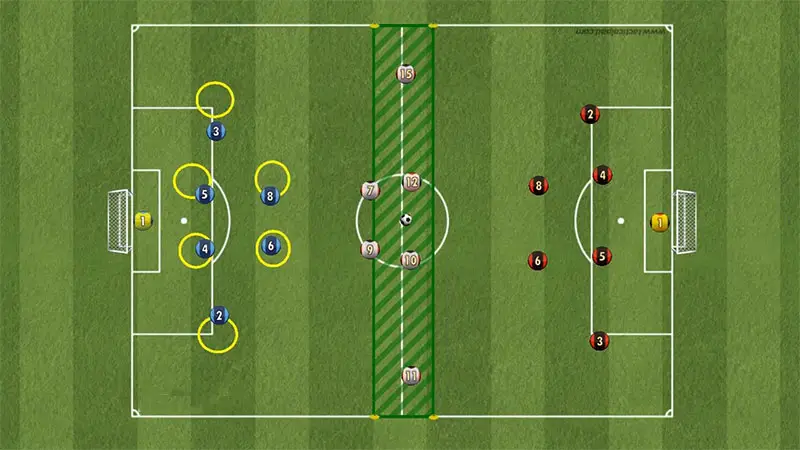In soccer, the defensive third is where a team’s mettle is truly tested. This critical area near the goal is where defenders must thwart opponents’ attempts to score. Understanding the dynamics of the defensive third can make the difference between victory and defeat.
Positioning and balance are key in this zone. Defenders need to be strategically placed to intercept passes and block shots. Effective defense in the defensive third isn’t just about individual skill; it’s about teamwork and communication.
Teams that master this area often find themselves with a significant edge in the game. Coaches often emphasize the importance of maintaining a compact shape to minimize gaps between players.
Additionally, quick decision-making and anticipating opponents’ moves can further enhance defensive resilience.
Key Concepts of the Soccer Defensive Third
The defensive third is the part of the field closest to a team’s own goal. Excellent play here can significantly influence the outcome of a game.
Key Concepts and Importance
In the defensive third, positioning matters. Players need to cover key areas to prevent opponents from penetrating. Balance within the team minimizes gaps, ensuring that space is controlled and attackers are marked.
Teamwork and communication are crucial. Defenders must coordinate with midfielders and the goalkeeper to maintain a solid defensive line. Clear communication helps avoid confusion and ensures everyone knows their role.
Defending in the third requires anticipation. Players should read the game to intercept passes and block shots. Quick reactions and tactical awareness are vital for preventing goals.
Common Formations and Setups
Different teams use various formations to strengthen their defensive third. The 4-4-2 setup involves four defenders and four midfielders working together to protect the goal area.
The 5-3-2 formation uses five defenders for extra coverage, effective against strong attacking teams. The 4-3-3 formation focuses on pressing high to reclaim the ball before it reaches the defensive third, requiring high stamina and quick transitions.
By understanding and using these formations, teams can better secure their defensive third and reduce opponents’ scoring opportunities.
Skills Required in the Defensive Third
In the defensive third, players must showcase specific skills to secure the area and prevent opponents from scoring. These skills are crucial for maintaining control and stability in this critical part of the field.
Communication and Coordination
Effective communication and coordination are essential in the defensive third. Clear instructions and constant talking among defenders, midfielders, and the goalkeeper can prevent confusion and ensure that each player knows their role.
For example, defenders must alert each other about potential threats and organize their positioning. Coordinating with the goalkeeper for offside traps and marking schemes can significantly reduce the chances of conceding goals.
Defensive Techniques: Blocking and Tackling
Mastering defensive techniques like blocking and tackling is vital for players in the defensive third. Blocking involves positioning the body to intercept or deflect passes and shots, often requiring quick reflexes and anticipation.
Tackling, whether standing or sliding, demands precise timing to dispossess the opponent without committing fouls. Players must be adept at these techniques to halt attackers and regain possession, thus controlling the tempo of the game and initiating counter-attacks.
Strategic Play in the Defensive Third
Effective play in the defensive third is crucial for maintaining possession and setting up offensive opportunities. Teams must focus on decision-making, organization, and communication to excel.
Decision Making When Playing Out From the Back
Players in the defensive third face constant pressure from opponents, making decision-making essential. Identifying passing options and reading the game quickly allows defenders to play out from the back effectively.
For example, starting from the goalkeeper’s distribution, defenders and midfielders should assess the best route to advance the ball. Technical proficiency in short and long passes enables flexibility.
If space allows, pushing the ball forward to a midfielder like the number 6 can create attacking opportunities. Maintaining positioning and anticipating opponent movements reduce the risk of turnovers.
Transitional Defense to Offense
Transitioning from defense to offense requires seamless coordination and quick thinking. Once possession is regained, defenders should immediately switch roles to support counter-attacks by utilizing the field’s width and exploiting spaces behind the opponent.
A defender winning the ball needs immediate support to maintain momentum, with effective communication and spacing to avoid crowding passing lanes. This strategy aims to create numerical superiority in attacking zones, aiding in breaking through compact defenses.
Strategic play in the defensive third ensures effective defense and smooth transitions to offensive plays.
Coaching Points for the Defensive Third
Effective coaching in the defensive third boosts team performance. Specific drills and careful analysis of game situations aid defenders’ tactical development.
Training Drills and Exercises
Training drills and exercises in soccer’s defensive third enhance positioning, communication, and tactical awareness, crucial for effective defensive play and team coordination.
Positional Drills
Utilize cones or markers to delineate positions. Players practice maintaining formation under pressure. For instance, setting up a 4-4-2 formation helps players understand spacing and support.
Counter-Attack Scenarios
Implement drills where players rapidly transition from defense to offense. For example, after intercepting a pass, defenders quickly push forward to create scoring opportunities.
1v1 and 2v2 Defending
Engage in drills emphasizing individual and small group defending. Players learn to tackle, block, and recover efficiently. This drill sharpens anticipation and reaction under pressure.
Passing Patterns
Develop passing sequences starting from the goalkeeper or center-back. Patterns like ‘4 to 2, 2 to 6, 6 to 7, and 7 dribbling to 9’ foster smooth transitions and decision-making in build-up play.
Analysis and Tactical Sessions
Analysis and Tactical Sessions in soccer involve strategic planning and review of gameplay to refine defensive strategies and optimize team performance effectively.
Video Analysis
Utilize game footage to review defensive plays. Highlight moments where players successfully thwarted attacks or made errors. Discuss decision-making processes and alternative actions.
Tactical Board Sessions
Conduct sessions with a tactical board to visually dissect defensive strategies. Play out different scenarios, such as dealing with high-pressure situations or maintaining shape against counter-attacks.
Live Game Observations
Have players watch live matches focusing on defensive formations and transitions. Encourage them to note how professional teams deal with similar high-pressure situations and recover after losing possession.
Simulation Drills
Recreate match scenarios in training. For example, simulate defending against a high press and transitioning to attack. This helps players recognize patterns and make quick, effective decisions on the field.
Frequently Asked Questions
Why is positioning important in the defensive third?
Positioning is crucial in the defensive third because it helps players cover key areas, mark opponents, and intercept passes. Good positioning can disrupt the opponent’s attacking moves and reduce their scoring opportunities.
How does teamwork influence performance in the defensive third?
Teamwork in the defensive third involves communication and coordination among defenders to cover spaces and support one another. Effective teamwork ensures that defensive responsibilities are shared, reducing the likelihood of defensive breakdowns.
What training drills are effective for improving defensive skills?
Effective training drills for the defensive third include positional drills, counter-attack scenarios, 1v1 and 2v2 defending, passing patterns, and simulation drills. These exercises help players develop tactical awareness, decision-making, and transition skills.
How can video analysis benefit defenders?
Video analysis allows defenders to review their performance and identify areas for improvement. By analyzing game footage, players can better understand their positioning, anticipate opponents’ moves, and refine their strategies accordingly.
What are the key attributes of a successful defender?
A successful defender should possess tactical awareness, strong positioning, anticipation, communication skills, and the ability to tackle and block effectively. These attributes help in not only stopping attacks but also starting offensive plays from the back.
Conclusion
Mastering the defensive third is crucial for any soccer team aiming to achieve consistent success. Effective strategies and well-honed skills in this area can significantly reduce the opponent’s scoring opportunities.
By focusing on anticipation, tactical awareness, and seamless communication, defenders can create a formidable barrier.
Incorporating targeted coaching methods like positional drills, counter-attack scenarios, and video analysis can elevate a team’s defensive capabilities. These practices not only enhance individual skills but also foster better teamwork and coordination.
Ultimately, a strong defensive third lays the foundation for a balanced team, capable of transitioning smoothly from defense to offense and maintaining control throughout the game.
Maintaining discipline and composure in the defensive third can prevent costly mistakes. It’s essential to train defenders to make quick, intelligent decisions under pressure, ensuring they maintain a solid backline.








Brice Petersen